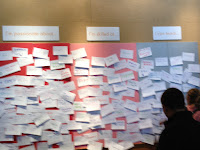Discover how libraries can strengthen their roles as catalysts for social engagement. Lead by example through creative partnerships and innovation in our ever-changing, hyperlinked world where everything is connected.As with the other tracks, this was a full-day "immersive experience." The track was led by Dr. John L. McKnight and John Creighton, both of whom have worked with communities to become connected. Their overall message is that we should not use labels to group members of our community together. Instead, we need to see our communities are being made up of individuals, who have different skills and passions. To that end, we did three exercises where we talked about our skills, passions, and topics we could teach. What we learned is that we're more complex than how we tend to acknowledge. I'm looking forward to duplicating this exercise with my students and colleagues.
In understanding our community, and the assets that make up our community, we need to look at:
- The individual and each person's assets - skills, knowledge and gifts of local residents.
- Associations - These are groups of people come who come together because of something that they have in common. In an association, it is the members who do the work.
- Institutions - Our institutions are hierarchical.
- Physical space
- The exchange of goods and/or services. This exchange does not require money.
- individuals, associations, institutions, physical space, exchange. 1st three are people. Associations are held together by care.
I cannot convey in words my understanding of the relationship of these five areas. However, I can tell you that when you begin looking at the skills of people and the associations to which they belong, you begin to see the assets that are available in the community. These are not monetary assets, but rather skills and connections. (And connections can help the library obtain money.)
Our homework on Monday night was to conduct community interviews, the results of which will be used by the public library in Telluride. In the community interviews that we did, we used a Community Asset Survey:
Afterward, we discussed how we might alter this survey for our own community. We also discussed that this type of survey would likely be one of many activities that we would do in order to understand our communities better.
We did compile our survey results (in small groups) and it was amazing what we learned. I'm confident that anyone who does this will learn from it. Of course, the next step is to use what you learn!
Two books mentioned during the session were:
- Saul Alinsky.
Two parting thoughts:
Many feel that libraries should be places of learning through teaching. Imagine if we turned to our community members and asked them what they want to learn AND what they can teach? And then imagine acting on that information!
Okay...so the word "client" isn't what most people would use, but it is what Dr. McKnight used. I do like this sentiment. We need to engage the members of our community and get involved with them. We're not in a lab running "hands-off" experiments...we're trying to change lives and improve our communities.
Edited 2/8/2024: Book URLs and R2Q URL updated.








1 comment:
I like how you report out on your experience with your tweets. Thanks for sharing.
Post a Comment